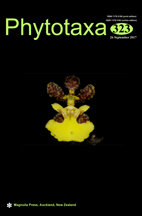Abstract
The genus Gleadovia was described by J.S Gamble and D. Prain (1900: 488) including a single species, G. ruborum Gamble & Prain (1900: 489) on the base of plants collected in 1898 from Bodyar, Jauansar in N.W. Himalaya. The genus is represented now by 3 species distributed in India and China. These species are: G. ruborum Gamble & Prain (India and China), G. mupinense Hu (1939: 2) (China) and G. banerjiana Deb (1956: 799) (India). G. ruborum is characterized by ovate or oblong leaves, 3- to several pedicelate flowers clustered at stem apex, obovate bract, spatulate-oblanceolate bracteoles, a tubular-campanulate calyx funnelform upward, much shorter than corolla, to 1.8 cm in diam., comparatively shorter pedicel, to 2.5 cm long and by corolla glabrous abaxially, villous adaxially (J.S. Gamble 26949-K! (K000999865, K000999866); CAL! (Acc. No. 329959)), whereas G. mupinense is characterized by oblong-lanceolate or lanceolate leaves, 3- to several pedicelate flowers borne on upper part of stem, oblong-lanceolate bract, linear-lanceolate bracteoles, a tubular calyx slightly enlarged upward, much shorter than corolla, to 1.2 cm in diam., longer pedicel, to 9 cm long and by densely villous corolla lobes on both sides (T.T. Yu 2189-PE! (PE - 1643589-00032337)), while G. banerjiana is characterized by lanceolate or ovate-lanceolate, spatulate leaves, 1–3 subsessile, ebracteate, ebraceolate flower(s) borne at the stem apex, a spathaceous calyx more or less equal to corolla, to 4.5 cm in diam. and densely hairy corolla lobes inside (D.B. Deb 2247A-CAL! (Acc. No. 329964)). When Gamble and Prain (1900) described G. ruborum, they mentioned in the protolouge the collections of J.S. Gamble, F. Gleadow, J.F. Duthie and Duthie’s collectors collected in 1898 from Bodyar, Jaunsar in N.W. Himalaya. Thus the cited authentic collections consist of several elements collected by different collectors. Therefore it warrants the typification under Art. 9.5 of the International Code of Nomenclature (McNeill et al. 2012). Hence a lectotype is designated here from the original collections.

